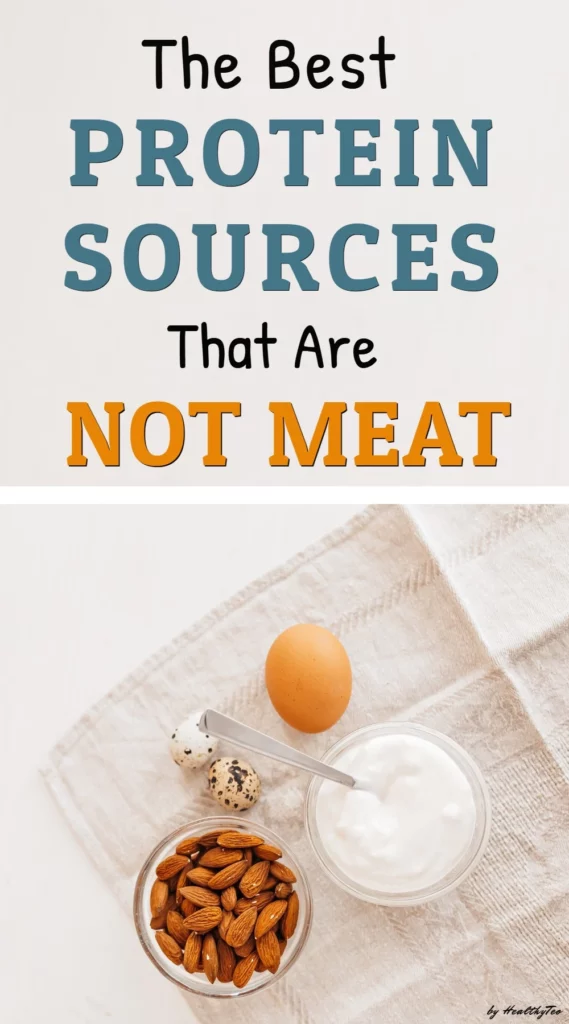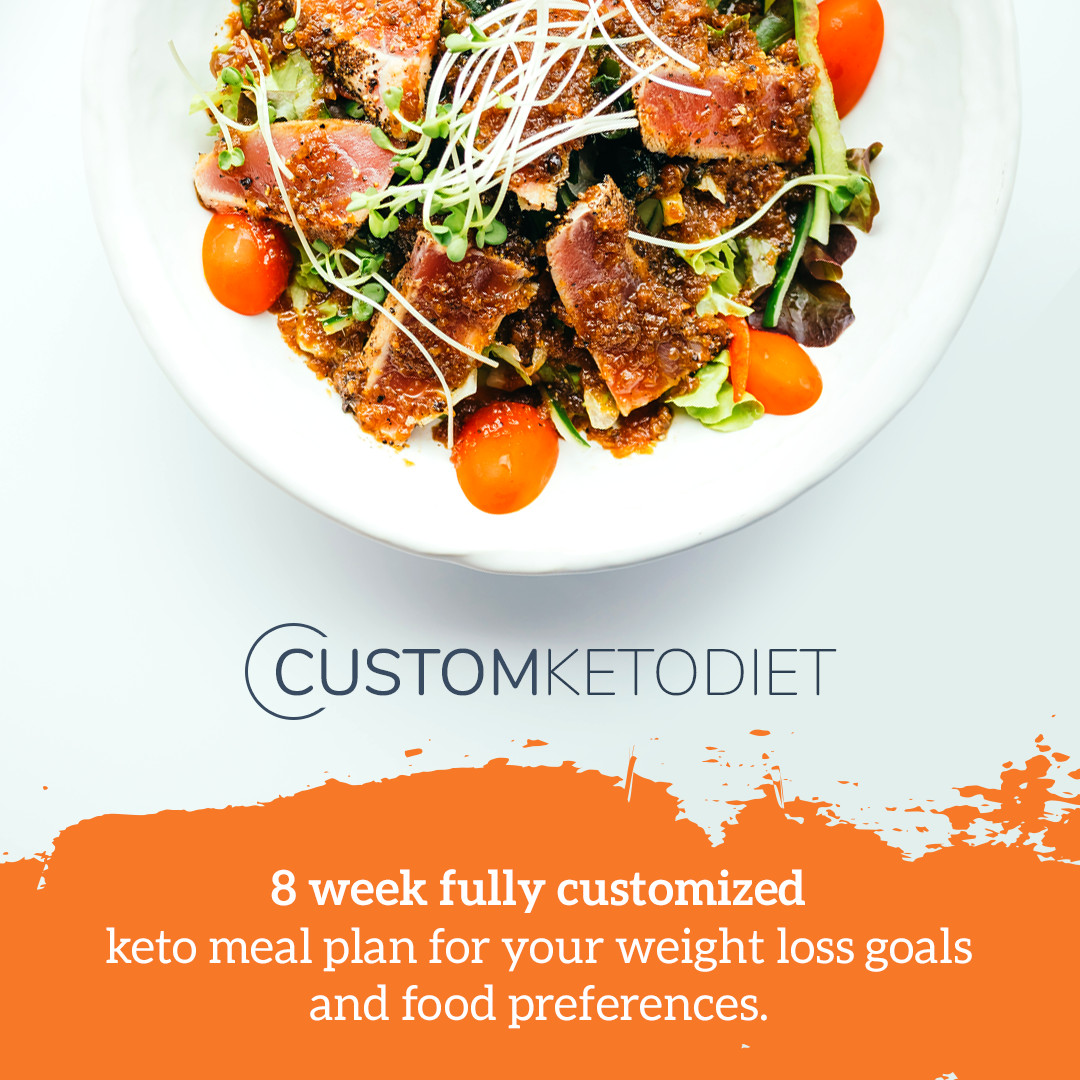List of 17 protein sources other than meat
If you want to avoid meat and meat products but still get enough protein there are many protein sources available that aren’t meat.
This article will provide you with a list of the top non-meat protein sources.
Before we get into that list, let’s go over some fundamentals about how much protein you should consume each day and why protein is so important!
This post may contain affiliate links, which means we may receive a small commission, at no cost to you, if you make a purchase through a link. For more information, please see our disclosure.
How much protein do you need to eat every day?
Protein can be found in almost every body part or tissue, including muscle, bone, skin, and hair. A chain of amino acids is the basic structure of a protein. Protein is required in your diet to assist your body in cell repair and cell formation.
During digestion, protein foods are broken down into components known as amino acids. The human body requires a variety of amino acids in sufficient quantities to maintain good health.
According to Harvard Health Publishing, the Recommended Dietary Allowance (RDA) for protein is a modest 0.8 grams of protein per kilogram of the body weight or 0.36 grams of protein per pound of body weight. That works out to about 54 grams for a 150-pound adult.
The RDA is the amount of a nutrient that is required to meet your basic nutritional needs. In a sense, it’s the amount you need to avoid getting sick, rather than the amount you’re supposed to eat every day. To calculate your daily protein intake, multiply your body weight in pounds by 0.36.
It is not necessary for most people to count or track how much protein they consume on a daily basis. Just make sure you have some with each meal.
If you find yourself feeling weak or fatigued on a regular basis, or if you get hungry soon after eating a meal, these could be signs that you’re not getting enough.
Protein is not only about quantity but also about quality.
In general, animal protein provides all essential amino acids (amino acids that cannot be produced by the body and must be obtained from food) in the proper ratio for you to fully utilize them.
You don’t have to eat animal products to get all of the protein you need in your diet. There are numerous non-meat protein sources that we will present to you down here.
Protein sources that aren’t meat
Tofu, tempeh and edamame
Soybeans are used to make tofu, tempeh, and edamame. They are complete proteins, which means they contain all nine essential amino acids required by the body to build and repair protein tissues.
Tofu is made from coagulated soy milk that has been pressed into white blocks and comes in a variety of textures such as silken, firm, and extra-firm.
Tofu does not have a strong flavor, but it readily absorbs the flavor of the ingredients with which it is prepared.
A 3-ounce (85-gram) serving of tofu contains about 8 grams of protein.
Many people who don’t eat meat use tofu as the main protein in a meal. It can be prepared in a variety of ways to keep it from becoming monotonous.
Tempeh is a plant-based protein source made from fermented soybeans shaped into a block. Although store-bought tempeh frequently contains additional beans and grains. It has a much chewier and nuttier texture than tofu.
Since the 1970s, when it became widely available in the West, tempeh has been a popular non-meat protein source, especially in vegetarian and vegan cooking.
3 ounces (85 grams) of tempeh contain 11 grams of protein.
Edamame beans are whole, immature soybeans, also known as vegetable-type soybeans. They are green, as opposed to regular soybeans, which are light brown, tan, or beige.
They are frequently sold while still encased in their pods, which are not edible. Shelled edamame can also be purchased without the pods. They are traditionally prepared with a pinch of salt and added to soups, stews, salads, and noodle dishes, or eaten as a snack.
A 1/2 cup (85 g) serving of whole edamame contains 8 g of protein, according to the USDA.
Eggs
Eggs are a high-quality protein source. They have almost exact amounts of all the necessary building blocks.
An egg contains about 6-7 grams of protein on average.
However, the protein content of the egg is affected by its size. Here’s how much protein different sizes of eggs contain:
- Small egg (38 grams): 4.9 grams of protein
- Medium egg (44 grams): 5.7 grams of protein
- Large egg (50 grams): 6.5 grams of protein
- Extra-large egg (56 grams): 7.3 grams of protein
- Jumbo egg (63 grams): 8.2 grams of protein
People frequently believe that protein can only be found in egg whites. The yolks of eggs are known to contain almost all of the nutrients and fat. However, the yolk contains up to half of the egg’s protein content.
A large egg contains about 7 grams of protein, with 3 grams coming from the yolk and 4 grams coming from the white. To get the most protein, eat the entire egg rather than just the white.
Furthermore, a study published in the Journal of Nutrition confirms that protein from cooked eggs is better absorbed by the body than protein from raw eggs. This means that cooking eggs make the protein more digestible and available to the body.
Eating raw eggs also increases the risk of bacterial contamination and food poisoning.
Lentils
Lentils are well known for their lens shape and are frequently classified by color, which can range from yellow and red to green, brown, or black.
Lentils are a great meat substitute, with 18 grams of protein per cooked cup (198 g).
It’s important to remember that lentils are not complete proteins.
So, if you’re plant-based, lentils shouldn’t be your only source of protein. By combining them with other non-meat protein sources such as brown rice, soy, or other legumes, you can ensure that your body gets the right balance of amino acids.
Chickpeas and most varieties of beans
Beans such as kidney, black, pinto, and most other varieties are high in protein. Chickpeas, also known as garbanzo beans, are another protein-rich legume.
Beans and chickpeas both have about 15 grams of protein per cooked cup (164 grams).
Most beans, like most plant foods, do not provide complete protein. As previously stated, the exception is soybeans and foods made from them.
Pair beans with foods like grains and dairy to ensure you’re getting all of the essential amino acids in your diet. Consuming beans with rice, hummus with pita wedges, or lentil soup with whole-grain bread or a dollop of yogurt will provide you with a complete amino-acid profile.
Dairy products
Milk, cheese, and yogurt are all high in protein and calcium. Choose cottage cheese or plain Greek yogurt to get the most protein bang for your buck.
Both have 13 grams of protein or more per serving and can be topped with fruit, nuts, or granola for a filling breakfast or snack.
Quinoa
Quinoa is a grain crop grown primarily for its edible seeds. In other words, it is essentially a seed that is prepared and consumed similarly to a grain.
Quinoa, unlike some other plant proteins, is a complete protein and is also naturally gluten-free.
One cup (185 grams) of cooked quinoa contains approximately 8 grams of protein.
Quinoa can be substituted for rice in most recipes. It can also be made into a creamy protein-rich breakfast porridge by simmering it in milk.
Quinoa comes in over 120 different varieties. White and yellow quinoa has the mildest flavors, so they are the best to start with. Red and black quinoa have slightly stronger earthy flavors and hold their shape better than lighter colored quinoa.
Amaranth
Technically, amaranth (like quinoa) is a pseudocereal, not a grain, but because of its similar nutrient profile, it is used as a grain and considered a whole grain.
One cup (246 grams) of cooked amaranth contains approximately 9 grams of protein, making it one of the best non-meat protein sources.
Furthermore, it is naturally gluten-free and can be consumed by those following a gluten-free diet.
Amaranth is a versatile grain that can be cooked as a side dish or porridge, or tossed in a skillet to add texture to granola bars or salads. It has a delicate, nutty flavor and retains its crunch even when cooked, similar to quinoa.
Oats
Many people are aware of the benefits of oats for providing energizing carbohydrates and fiber to begin their day. However, oats and oatmeal are good sources of natural protein for people who want to increase their protein intake without eating more meat.
One cup of dry oats, or 81 grams, contains about 10 grams of protein.
However, if cooked with milk and topped with almonds for a complete meal, the protein content of oatmeal can be increased.
Although oats are not a complete protein, they do contain higher-quality protein than other commonly consumed grains such as rice and wheat.
Oats can be used in a variety of recipes, from oatmeal to veggie burgers. They can also be ground into flour and used for baking.
Buckwheat
Buckwheat is another pseudocereal that is a plant-based source of complete protein. It contains less protein than quinoa or amaranth, but the protein in buckwheat is of very high quality due to its well-balanced amino acid profile.
One cup (168 grams) of cooked buckwheat groats contains about 6 grams of protein.
Buckwheat, like other pseudocereals, is gluten-free and thus suitable for gluten-intolerant people.
Ezekiel bread
Ezekiel bread contains sprouted whole grains and legumes such as barley, soybeans, wheat, lentils, millet, and spelt.
Two slices of Ezekiel bread (68 grams) contain 8 grams of protein.
All grains and legumes are grown organically and allowed to sprout before being processed, combined, and baked to create the final product.
Unlike most bread, Ezekiel bread’s combination of whole grains and legumes provides all nine essential amino acids.
Because wheat, barley, and spelt all contain gluten, this bread is out of the question for those who are gluten intolerant.
Nuts
Whatever nut you prefer, it is most likely a good source of protein. Nuts are an excellent protein-rich snack or addition to meals. They’re versatile and convenient to eat on the go.
Here is a list of the protein content of various nuts:
Peanuts – 9.5 grams of protein per 1/4 cup (37 gram) serving.
Peanuts are technically a legume, but in terms of culinary and nutritional value, they are classified as a nut. They have the highest protein content of any commonly consumed nut.
Almonds – 7 grams of protein per 1/4 cup (35 gram) serving.
Almonds are technically a seed, but they are often grouped with nuts and regarded as a high protein option. Pair almonds with a piece of fruit for a balanced snack.
Pistachios – 6 grams of protein per 1/4 cup (30 gram) serving.
Pistachios have a higher ratio of essential amino acids than any other nut, with protein accounting for about 20% of their weight. Blending pistachios into nut butter to eat on toast, apples, or crackers is a fun way to eat them.
Cashews – 5 grams of protein per 1/4 cup (32 gram) serving.
Keep in mind that some roasted and salted cashews may have significant amounts of added oils and salt. If you want to avoid extra salt or fat, opt for dry roasted or “raw” unsalted cashew varieties whenever possible.
Hazelnuts – 5 grams of protein per 1/4 cup (34 gram) serving.
Make your own “Nutella” spread for a high-protein snack: 1 cup (135 g) hazelnuts combined with 2 scoops (60 g) chocolate protein powder, 1 tablespoon (6 g) cocoa powder, and 2 tablespoons (30 mL) maple syrup.
Brazil nuts – 4.75 grams of protein per 1/4 cup (33 grams) serving.
For a protein-rich trail mix, combine Brazil nuts with other nuts and seeds, dried mango, and dark chocolate chunks.
Pine nuts – 4.5 grams of protein per 1/4 cup (34 grams) of pine nuts.
Toasted pine nuts are an excellent way to add protein to salads, grain bowls, or vegetables.
Walnuts – 4.5 grams of protein per 1/4 cup (29 gram) serving.
Including walnuts in your diet is a great way to increase your protein and omega-3 fatty acid intake.
Peanut butter
Yes, the childhood favorite is tasty and a good source of high-quality plant-based protein.
According to the USDA, 2 tablespoons of peanut butter contain 7.2 grams of protein.
Just make sure to buy healthy varieties and limit your portion size – the aforementioned portion has a whopping 180 calories, so it can quickly switch from a healthy protein source to an indulgent treat that may contribute to weight gain if you overdo it.
Chia seeds
Chia seeds contain about 14 percent protein by weight, which is very high when compared to most plants.
A one-ounce (28-gram) serving of chia seeds, or two tablespoons, contains 4 grams of protein. This is especially impressive given that it is only one ounce.
They also have a good balance of essential amino acids, which means your body should be able to utilize their protein content.
There are numerous ways to incorporate chia seeds into your diet. They can be used to make pectin-free jams and puddings. In vegan baking, chia seeds are frequently used as an egg substitute.
Chia seeds are an excellent source of protein, especially for those who consume little or no animal products.
Hemp seeds
Protein accounts for approximately 25% of the calories in hemp seeds, which is a relatively high proportion.
By weight, hemp seeds have the same amount of protein as beef and lamb – 30 grams of hemp seeds, or 2-3 tablespoons, have about 11 grams of protein. That is 50 percent more than flaxseed or chia seeds.
They are considered a complete protein source, and the digestibility of hemp protein is excellent – better than that of many grains, nuts, and legumes.
Seitan
Seitan is a popular vegan meat substitute. It is entirely composed of hydrated gluten, the primary protein found in wheat. As a result, it’s also known as wheat gluten, wheat meat, wheat protein, or simply gluten.
The precise amount of protein in seitan varies depending on whether other proteins, such as soy or legume flours, were added during the manufacturing process.
A 3-ounce serving of seitan typically contains between 15 and 20 grams of protein, which is roughly equivalent to animal proteins such as chicken or beef.
While seitan is high in protein and a great non-meat protein source, it lacks enough amino acid lysine to meet your body’s requirements.
Seitan is not considered a complete protein because it lacks lysine.
Many vegans and vegetarians easily solve this problem by eating lysine-rich foods like beans to meet their requirements.
Because seitan is made from wheat flour, it should be avoided by people who are allergic to wheat or gluten. This includes people who are allergic, sensitive, or intolerant to gluten, as well as those who have celiac disease.
If you’ve never tried seitan and aren’t allergic or sensitive to gluten or wheat, you can use this recipe to make your own seitan at home.

Final thoughts on the best non-meat protein sources
If you decide to avoid eating meat and meat products, this list of 15 protein sources that aren’t meat will help you to get enough protein.
The protein content of these non-meat protein food sources varies. Some are considered complete proteins, while others are not.
If you decide not to eat meat, try incorporating a variety of these protein sources or combinations of them into your diet to ensure you meet your amino acid needs. If you want to learn more about combining proteins, check out this article.




